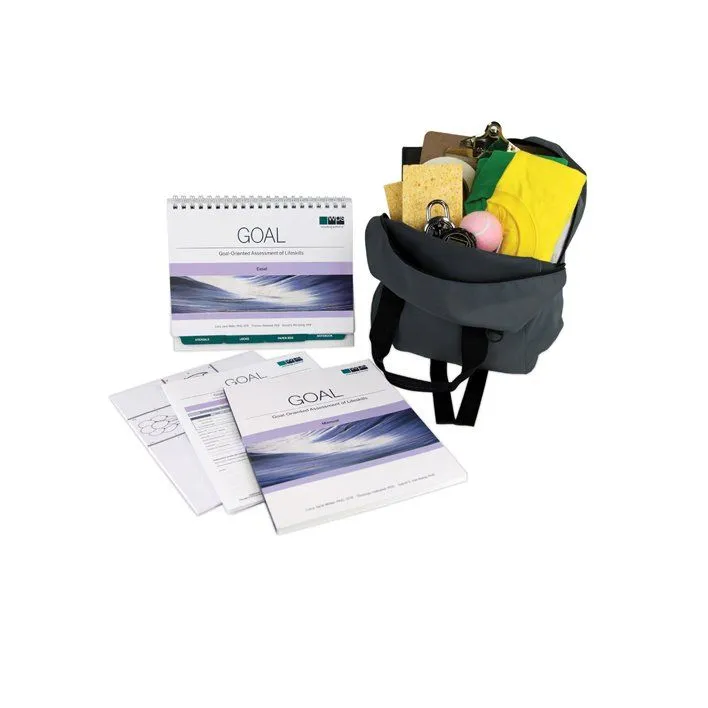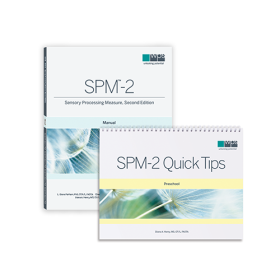(GOAL™) Goal-Oriented Assessment of Lifeskills
(GOAL™) Goal-Oriented Assessment of Lifeskills
From $40.00
To $1,181.00
In stock
Download Sample Materials

Sign In to download sample materials.
Don't have an account? Register Here.
About This Product

life skillsBY LUCY JANE MILLER, PHD, OTR, THOMAS OAKLAND, PHD, AND DAVID S. HERZBERG, PHD
Introduction
The Goal-Oriented Assessment of Lifeskills (GOAL) is an innovative new evaluation of functional motor abilities needed for daily living. Designed for children 7 to 17, the GOAL consists of seven Activities, fun and motivating tasks based on real occupations of a child’s daily life. Each activity is linked to Intervention Targets that help you turn assessment results into a specific, goal-oriented treatment plan. This standardized, psychometrically precise instrument offers an ecologically valid description of a child’s competencies and opportunities for growth in both fine and gross motor domains.
The GOAL can help determine eligibility for special services and inform planning of occupational and/or physical therapy and adaptive physical education. It’s useful in a variety of settings, including schools, clinics, hospitals, and private practice. Although intended primarily for occupational therapists, it can be used by other professionals, including psychologists, physical therapists, and other childhood intervention specialists.
Administration, Scoring, and Applying Results to Treatment
In this individually administered assessment, the child performs seven Activities representing a range of functional tasks. Dr. A. Jean Ayres’ sensory integration theory describes many of the key concepts underlying GOAL Activities. This theory proposes that the processing of sensory inputs provides a foundation for the development of cognitive and motor skills.
Activities
Fine Motor:
Utensils: Using a knife, fork, and spoon to cut, spear, and scoop
Locks: Opening keyed and combination padlocks
Paper Box: Coloring, cutting, folding, and taping a paper construction project
Notebook: Organizing and filling a three-ring binder
Gross Motor:
Clothes: Putting on and taking off a T-shirt and shorts
Ball Play: Bouncing and kicking a ball
Tray Carry: Carrying a loaded tray and avoiding obstacles
The innovative Record Form follows the natural workflow of an assessment: from recording the child’s performance, through calculating and interpreting scores, to developing a treatment plan. The center panel of the form, the Progress Chart, allows you to graph the child’s overall functional ability and identify specific targets for intervention. On the right panel of the form are the Intervention Targets,which allow the examiner to link the child’s performance to specific intervention objectives. There are four columns on this panel—Sensory, Postural, Praxis, and Motor Proficiency—showing the Intervention Targets associated with each Activity. Each row of the Record Form has a set of Intervention Targets associated with the underlying component skills needed for that specific Functional task.
The GOAL scores are based on 54 Steps—small units of easily observable, functional behavior within the seven Activities. These are scored based on three elements of successful functional performance: accuracy, independence, and speed. Using the Record Form, each Step is scored pass or fail; then the Step scores are summed to yield the Fine Motor and Gross Motor Standard Scores, as well as the Progress Score.
The Standard Scores enable you to compare the child you are testing to peers of the same age and gender, and can help to determine eligibility for therapeutic services and placement in special education programs. The Progress Score is a single index of the child’s overall ability to perform functional tasks, and can be used to track improvement over time.
Select the media tab to view a brief video demonstration of administering the GOAL. This video does not replace the manual instructions, and it is recommended that the administration section of the manual be read thoroughly. Additional training on the administration, scoring, and interpretation of results is offered through a full-day workshop provided by the SPD Foundation. Please visit www.spdfoundation.net for further details.
Standardization and Psychometric Properties
The GOAL Activities were standardized on a sample of 616 children ages 7 to 17, drawn from all four geographic regions of the United States. A clinical sample of 152 children referred to occupational therapy for mild to moderate sensory and/or motor challenges was also collected.
Statistical analysis of the GOAL demonstrates good reliability and validity. In addition, it also provides clear evidence that it is a useful tool for distinguishing typically developing children from clinic-referred children, including those with sensory and motor disorders, autism spectrum disorders, ADHD, and learning disabilities.
Reliability
Analysis of the standardization sample shows acceptable internal consistency correlations for both the Fine and Gross Motor Standard Scores (all >.75). These are consistently higher in the clinical sample (>.84), which represents the target population for the GOAL Activities. Internal reliability for the Progress Score is .90. Test–retest reliability data for the clinical sample demonstrate acceptable correlations of .76 for the Fine Motor Standard Score and .77 for the Gross Motor Standard Score.
Validity
Convergent validity data were collected for four assessments: the Sensory Integration and Praxis Tests (SIPT), the Sensory Processing Measure (SPM), the Bruininks-Oseretsky Test of Motor Proficiency, Second Edition (BOT-2), and the Adaptive Behavior Assessment System, Second Edition (ABAS-II). Scores generally correlate in expected ways with these measures, showing acceptable evidence of construct validity.
Reliably Distinguishing Typically Developing Children From Clinic-Referred Children
The differences in mean standard scores between the standardization and clinical samples represent large, clinically significant effect sizes. Analysis from the samples demonstrate good sensitivity and specificity:
- 74% of the clinical sample had Fine Motor Standard Scores of 85 or less
- 85% of the standardization sample had Fine Motor Standard Scores of 86 or more
- 79% of the clinical sample had Gross Motor Scores at or below 85
- 87% of the standardization sample had Gross Motor Scores at or above 85
More information about the psychometric characteristics of the GOAL is included in Chapter 6 of the Manual.
Terms Often used to search for (GOAL™) Goal-Oriented Assessment of Lifeskills
Goal-oriented assessment of lifeskills, goal assessment, life skills assessment, manual, motor assessment, test
Chapter 4 of the GOAL Manual presents five case examples that demonstrate how the Activities form part of an integrated approach to assessment and treatment. The case examples provide a format for written reports that incorporates assessment results. Cases range from a child who is part of a regular-education classroom (see Janine’s case example below) to a child with severe disabilities who has never received any kind of therapy.
Janine: Progress in Motor Development After Intervention
Janine is a 7-year, 8-month-old girl in second grade who has been receiving special services at school since kindergarten. She receives OT at school for fine and gross motor difficulties as well as speech and language therapy for poor articulation, and shares an aide in the classroom with four other children. In addition to school services, she received intensive OT intervention, once a year for 6 weeks, at ages 4, 5, 6, and 7. With the intensive intervention and strong family support, she has remained in a regular-education classroom, and is succeeding academically and socially at school. The GOAL Activities were administered as part of a year-end individualized education program (IEP) review to determine if her special services should be continued.
Janine is an outgoing and friendly girl. She has a group of six close friends and a best friend, her cousin Alexandra. Although Janine’s mother does not want her daughter to grow up thinking that something is “wrong” with her, she acknowledges that the special services so far have been “a lifesaver.” Janine has blossomed from a shy, withdrawn girl who could not keep up with her peers, to an accepted member of her group with a strong sense of belonging.
Behavioral Observations
Janine came willingly with the occupational therapist at school for her evaluation. She was eager to show off her improved skills. She said, “I’m the boss of my body now.” The therapist knew that Janine had been working hard in private OT for the past few years, and wanted to see if Janine’s test scores would show improvement from her last evaluation 3 years earlier. The therapist noted that Janine appeared confident and calm, unlike at the previous testing, when she looked worried and asked how she did after every task. She was motivated and focused throughout the session. Her performance appeared to represent her best effort and true abilities.
Results: Standard Scores and Progress Score
On the GOAL Activities, Janine achieved a Fine Motor Standard Score of 92 and a Gross Motor Standard Score of 80. In the fine motor domain, her performance is at the 30th percentile, which is within the Average (typical development) range. However, in the gross motor domain, her performance is 1? standard deviations below the mean (9th percentile), which is in the Mild-to-Moderate Challenge range. The 90% confidence intervals around her Fine Motor and Gross Motor Standard Scores are 83–101 and 71–89, respectively. The two standard scores differ by 12 points, which is less than the threshold required for a statistically significant difference.
Janine’s Progress Score is 447, which represents her overall level of functional ability. Subtracting 50 from and adding 50 to the Progress Score defines her Progress Range of 397 to 497. This range enables the identification of unexpected successes and challenges on the GOAL Steps, which can illuminate useful routes for OT intervention.
Results: GOAL Steps
Unexpected successes. Janine demonstrated unexpected successes on five Steps spread among Utensils, Locks, Paper Box, and Tray Carry. These Steps represent strengths in areas where, given her Progress Score, she was expected to struggle.
Janine quickly and accurately scooped water with a spoon, sipped from the spoon, and transferred the water to a second cup (U6, U7). She opened a combination lock similar to those found on a school locker (L2). She was precise and speedy in cutting paper with a pair of scissors (P6). She also performed quickly and accurately in maneuvering through space, sitting, and standing while carrying a clipboard with two cups full of water (T3), which is analogous to moving through a school cafeteria with a loaded tray.
Unexpected challenges. Janine was not successful on three Steps that she was expected to complete with relative ease, given her overall functional ability. These unexpected challenges may identify sensory–motor components that can serve as targets for treatment.
Janine’s coloring skills were sloppy (P1, P3); she made many crayon marks outside the boundaries of the umbrella and balloons. In addition, she struggled with the precise hand skills required to open and close the rings of a three-ring binder (N1).
Interpretation
The Intervention Targets section reveals the fine motor strengths underlying Janine’s unexpected successes. These include postural elements, such as alignment of upper extremities, stability, and feedback, which allowed her to perform efficiently while cutting paper with scissors. Strengths were also noted among the praxis elements of planning and sequencing, which enabled Janine to quickly execute the three-part task of scooping, sipping, and transferring water to another cup.
Given these strengths, it is surprising that she struggled with coloring the balloons and umbrella with crayons, which is an easier skill. She did appear to be rushing through this part of the Paper Box Activity. Janine’s difficulty with opening and closing a three-ring binder may have reflected issues with bilateral coordination and/or hand strength.
Among the gross motor Activities, the components of alignment and stability played a role in Janine’s unexpected successes, as did balance, weight shift, and feedback. These strengths were evident in Janine’s quick and accurate performance on Tray Carry, which requires the use of feedback from the environment to control balance and weight shift during forward movement. The GOAL assessment revealed no unexpected challenges among the gross motor Activities.
Applying GOAL Results to Intervention
The analysis of Intervention Targets reveals several areas of strength that apply to both fine and gross motor domains, which makes it curious that Janine’s Gross Motor Standard Score was in the range of Mild-to-Moderate Challenge. Looking at her unexpected failures, proprioception is an Intervention Target that underlies both the paper cutting and the three-ring-binder tasks. Proprioceptive deficits, which affect a child’s awareness of his body’s position in space, can affect both fine and gross motor functioning.
More specifically, proprioceptive discrimination may be a useful target for occupational therapy. Activities that focus on arm position will allow Janine to fully integrate her awareness of her position in space. These interventions should involve all parts of the upper extremities (e.g., shoulder, upper arm, elbow, lower arm, wrist, and fingers). By using weighted balls, sticks, and physical cues, the therapist can help Janine use her full arm for fine motor tasks, instead of just moving her fingertips. Janine shows a natural ability to focus intently on the task at hand, which should help the therapy to succeed. With improved proprioceptive discrimination, Janine’s alignment, stability, and higher level praxis abilities should also improve. This will in turn enhance her hand precision and endurance on fine motor tasks.
Janine’s parents should be given the option to continue occupational therapy. Janine’s GOAL results show significant improvement, especially in the fine motor domain, since she was last assessed 3 years ago. In the meantime, Janine’s occupational therapy appears to have made a difference. One more period of short-term intensive OT, focusing on proprioceptive discrimination, can help make Janine’s motor repertoire more automatic. When Janine matures in her discrimination of proprioceptive input, she will find herself less challenged by motor tasks in general. This will allow her to turn her attention to higher level cognitive tasks, including her schoolwork and relational skills.
Summary and Recommendations
Janine has made measurable progress on fine motor functioning since her initial assessment 3 years ago, when her standard scores on fine and gross motor tasks were below average. In the current assessment, the GOAL Fine Motor Standard Score improved to the Average range. Much of the improvement can be attributed to the combination of family support, special services at school, and yearly, short-term intensive occupational therapy. Most notable is her newfound but fragile self-esteem, based in part on her small group of accepting friends.
There are two functional areas where ongoing occupational therapy can continue to have a positive impact:
Impact of improved fine motor skills on social participation. Janine was referred originally in kindergarten for problems with making friends and difficulty in playing with others. Her examiner hypothesized that Janine’s social difficulties were due in part to motor planning issues, which made it harder for her to participate physically in peer activities. After 3 years of home- and school-based OT, both her fine and gross motor systems are functioning better, and Janine can participate in fun activities with peers, such as playing dress-up and house. Continuing OT would help Janine to consolidate these gains and prevent her from having to struggle physically to keep up with her friends.
Impact of underlying proprioceptive discrimination problem on school-related tasks. Janine still demonstrates difficulty on some tasks that require detection and discrimination of proprioceptive information (e.g., coloring, opening and closing a notebook). Better processing of proprioceptive stimuli will enable Janine to complete these tasks with less conscious effort. A more automated motor repertoire will help her school performance and lead to improved self-esteem.
Janine has already responded well to occupational therapy, but she still shows an overall mild-to-moderate challenge among her gross motor skills. Another “booster” of OT may help to coax these skills into the Average range. However, because she has shown significant improvement and her remaining problems are only in the mild-to-moderate range, Janine’s parents need clear feedback on the GOAL results so that they can make an informed decision about whether to continue treatment. By meeting with the parents prior to the IEP team meeting, the therapist will be able to provide detailed information about the GOAL assessment and answer the parents’ questions about the pros and cons of continuing treatment. This will support the family in making the best decision for Janine’s future.








